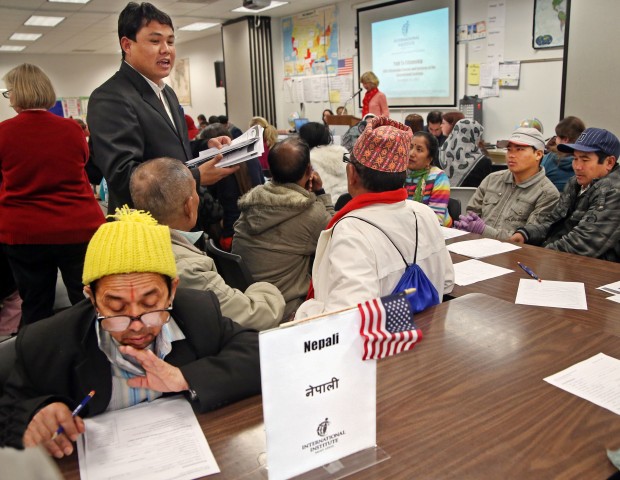I wonder does he fully understand that S.744 (the Senate “comprehensive” bill) will legalize 11 million plus alien workers who will compete with his fellow Bhutanese refugees who are already not finding employment, a situation some say is connected to a high suicide rate among ‘his people’ in America?
I don’t know how the refugee contractors can in good conscience lobby (along with big business interests like the meat packers!) for amnesty when they know that the refugee unemployment rate is through the roof.
The Lutheran Immigration and Refugee Services (all of the top nine federal refugee contractors are surely involved) is lobbying for this bill because it means more money for them to help get the newly legalized immigrants hooked up with ‘services.’ It doesn’t mean more money for the refugees. The contractors really are despicable—using refugees this way!
The Argus Leader of Sioux Falls, SD reports that Bhutanese refugee, Thag Poudyal, went to Washington paid for by the Lutherans (more likely the US taxpayer) to lobby.
Two weeks ago, he was chosen by the national Lutheran Immigration and Refugee Service to take his story to Washington, D.C., and lobby South Dakota’s congressional delegation about immigration reform, and for more dollars to protect and assist the more than 15 million refugees worldwide.
[….]
His participation as part of a World Refugee Day delegation to D.C. was significant for several reasons. Only two dozen refugees nationwide, representing many different oppressed groups, were selected to go. Poudyal was the lone representative from South Dakota.
[….]
After a day of training on issues important to the Lutheran Immigration and Refugee Service, Poudyal traveled to the offices of South Dakota’s congressional delegation and met with staffs for Sens. Tim Johnson and John Thune and Rep. Kristi Noem.
Poudyal asked that dollars for the State and Health and Human Services departments remain robust to protect and aid refugees. He lobbied for immigration reform, including an end to a one-year filing deadline for asylum claims, and that children of a refugee or the asylum seeker’s spouse be allowed to join their parents in this country.
[….]
To date, 68,000 Bhutanese have been resettled to the United States*, though Schwab [Roland Schwab. Lutheran Social Services director in Sioux Falls] expects that migration to Sioux Falls to slow considerably within the next year as the Nepalese refugee camps empty. Poudyal estimates that as many as 3,000 are here now because of direct resettlement or movement from other U.S. cities.
Many of his countrymen hope to go back to their homeland some day, including a 103-year-old Bhutanese man who has lived here only a short time, Poudyal said.
Readers, what do you think a 103-year-old refugee is living on? You guessed it—SSI! This reminds me, if you haven’t visited our newly updated fact sheet on the US refugee program, it is here.
Refugee Program should be stripped from the bill!
In a sidebar, the Argus Leader lists the issues in S.744 (the Gang of Eight plus Grover comprehensive amnesty bill) affecting refugee resettlement. As we have pointed out on numerous previous occasions, these are significant issues that should be addressed in thorough separate hearings on the Refugee Program that has never been seriously reviewed in three decades!
Refugees’ requests
About two dozen refugees from across the country, including Bhutanese refugee Thad Poudyal of Sioux Falls, went to Washington, D.C., on June 20 for World Refugee Day to lobby Congress. Among other things, they asked federal lawmakers for:
• $2.8 billion for the Department of State for migration and refugee assistance.
• $1.31 billion for the Department of Health and Human Services for refugee and entrant assistance.
• The elimination of a one-year filing deadline for asylum claims
• The enhancement of refugee family unity by allowing the child of a refugee or asylum seeker’s spouse to accompany or join their parents in the United States.
• The ability of the president to designate certain groups of refugees to be resettled in the United States. [This will be a huge deal—a refugee will no longer have to prove that he or she is personally persecuted, just being a member of a certain ethnic, social, or political group will get them in the door.—ed]
• The updating of legislation regarding services involved in the resettlement of refugees.
Readers, you must contact your Representative in Congress and tell him or her that you oppose “comprehensive” immigration reform and that the Refugee Resettlement Program must be reviewed separately and thoroughly by Congress.
Call on Monday just as American Black leaders rally at the Capitol in opposition to the amnesty legislation:
The Black American Leadership Alliance (BALA) has organized an anti-amnesty march and rally — the DC March for Jobs — in Washington, D.C. on Monday, July 15th. The goal is to “demand that our leaders reject amnesty, enforce immigration laws as written, and support policies that put black U.S. citizens back to work.”
* We have written extensively on Bhutanese refugees (mostly Hindus btw) originally approved for resettlement by the Bush Administration. We were to bring 60,000 in five years but we are now approaching 70,000.






